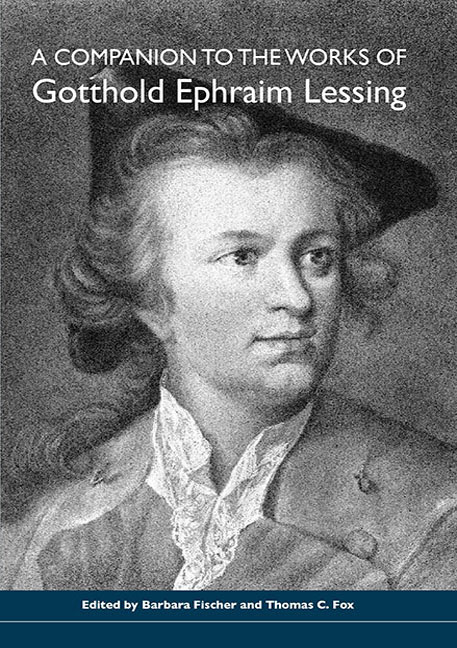Book contents
- Frontmatter
- Contents
- List of Illustrations
- Acknowledgments
- Lessing Editions and Abbreviations
- Selected Works by Lessing
- Introduction
- Lessing's Life, Work, and Times
- Criticism and Aesthetics
- Lessing the Critic: Polemics as Enlightenment
- Lessing and the Fable
- Lessing's Poetics as an Approach to Aesthetics
- Philosophy and Theology
- Drama and Drama Theory
- Reception
- Contact Organizations
- Works Cited
- Notes on the Contributors
- Index
Lessing and the Fable
from Criticism and Aesthetics
Published online by Cambridge University Press: 28 April 2017
- Frontmatter
- Contents
- List of Illustrations
- Acknowledgments
- Lessing Editions and Abbreviations
- Selected Works by Lessing
- Introduction
- Lessing's Life, Work, and Times
- Criticism and Aesthetics
- Lessing the Critic: Polemics as Enlightenment
- Lessing and the Fable
- Lessing's Poetics as an Approach to Aesthetics
- Philosophy and Theology
- Drama and Drama Theory
- Reception
- Contact Organizations
- Works Cited
- Notes on the Contributors
- Index
Summary
Kant's seminal definition of the Enlightenment in the essay “Beantwortung der Frage: Was ist Aufklärung?” (What is Enlightenment?, 1784) envisions the emergence of an ethically mature citizenry, whose members base their opinions on accurate observation and readily develop codes of behavior independently of the dictates of church and state. Such maturity presupposes an educational program for citizens that would enable the establishment of a strong moral and rational foundation in each individual. Though written toward the historical end of the Enlightenment and three years after Lessing's death, “Was ist Aufklärung?” articulates the period's pedagogical optimism, its belief that the impetus to reasoned, rational, virtuous conduct can be inculcated through judicious, exemplary teaching and role modeling. Since the age of Aesop, the fable had been regarded as among the most effective genres for guiding the individual in developing rational and moral discernment. Because the Enlightenment first took root in France toward the end of the seventeenth century, it is not surprising that the fable's revival at that time was primarily achieved at the behest of French authors such as Jean de La Fontaine (1621–1695) and René Le Bossu (1631–1680). Early in the eighteenth century, their lead was followed in Germany by such figures as Friedrich von Hagedorn (1708–1754), Christian Fürchtegott Gellert (1715–1769), and Johann Christoph Gottsched (1700–1766).
To be sure, there was a fundamental difference between the goals of fable writers and theorists in France and Germany. The French fabulists were less concerned with the education of mature, self-responsible citizens than with inculcating decorum and propriety (“bienséance”) in young people of means and title. This is the circumstance that largely motivated Lessing's refutation of French fable theory and practice. In Dichtung und Wahrheit (Poetry and Truth, 1811–1822), Goethe described the constellation of issues that popularized the fable during his youth, when Lessing was a key figure in German Enlightenment discourse. In the seventh book of Dichtung und Wahrheit, Goethe summarized the period's aesthetic grounding in the mimetic ideal; the painter imitates, strives to reproduce nature, and the writer should follow this model. However, such complete reproduction would cause one to include too much extraneous detail.
- Type
- Chapter
- Information
- A Companion to the Works of Gotthold Ephraim Lessing , pp. 89 - 104Publisher: Boydell & BrewerPrint publication year: 2005



